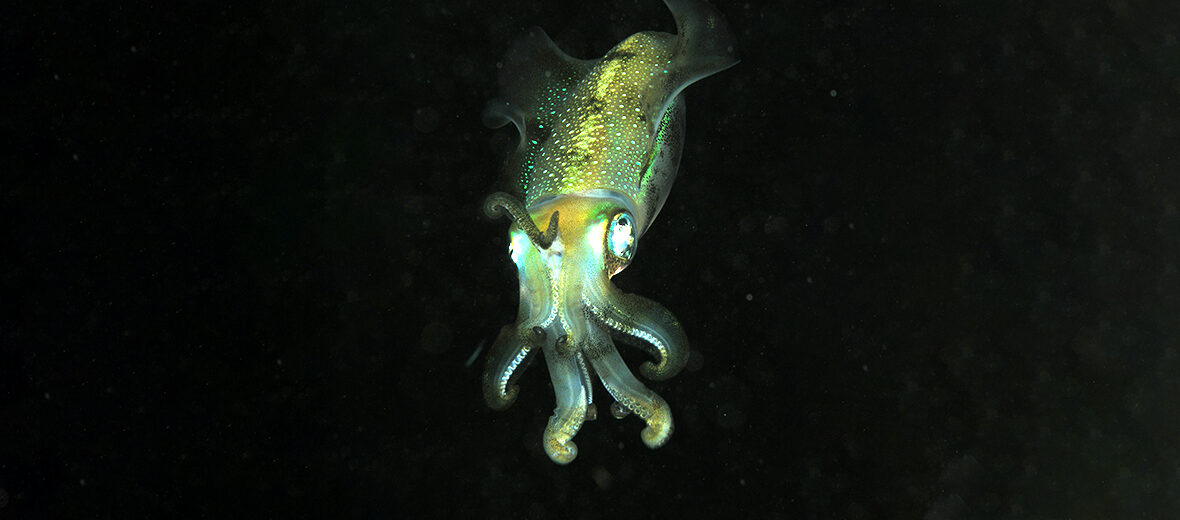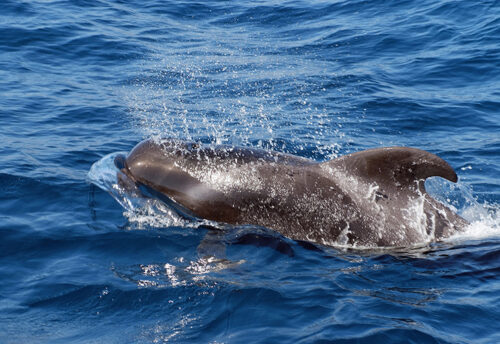
The bigfin reef squid, aka reef squid, glitter squid, green-eyed squid, oval squid, northern calamari, or tiger squid, have the fastest recorded growth rate of any large marine invertebrate. These and other squid species are threatened by overfishing. However, seeing as these squids are a cryptic species complex (a species complex is a group of closely related organisms that are so similar in appearance and other features that the boundaries between them are often unclear) they are listed as Data Deficient by the IUCN. Their population trend is also unknown.
First the Stats…
Scientific name: Sepioteuthis lessoniana
Weight: Up to 1.3+ lbs.
Length: Up to 13 inches
Lifespan: Up to 315 days
Now on to the Facts!
1.) These squids grow so fast that they can reach 1.3 lbs. in a mere 4 months.
2.) Because of their ability to tolerate being handled and their short lifespan, they are a highly regarded species for mariculture (marine farming or marine aquaculture).
3.) They are 1 of 3 currently recognized species classified under the pencil squid family.
4.) These critters were first described by the French naturalist André Étienne d’Audebert de Férussac and then named after René Primevère Lesson. A specimen was collected by Lesson off the coast of New Guinea during the circumnavigational voyage of the French corvette La Coquille from 1822 – 1825.
5.) Bigfin reef squids are easy to distinguish from other squids because they have thick and muscular oval fins that extend around almost the entire mantle. Due to this feature, they are often mistaken for cuttlefish.
But wait, there’s more on the bigfin reef squid!
6.) They can be found at depths of up to 328 feet.
7.) Reef squids possess iridophores (chromatophores – cells that can change color), notably in the head, which is a form of structural coloration that produces iridescent metallic greens and reds when illuminated.
Did you know…?
Like many other cephalopods, these squids are capable of metachrosis (rapidly changing body coloration and patterns through voluntary control of chromatophores).
8.) They tend to be more nocturnal (active at night).
9.) These squids are found in temperate and tropical regions throughout most of the world’s oceans.
10.) Prawns, a variety of other crustaceans, and various fish are all preyed on.
But wait, there’s still more on the bigfin reef squid!
11.) The rate of prey consumption is 1 prey item every 2 – 25 hours.
12.) Marlin, swordfish, tuna, and rays all prey on these squids.
Did you know…?
They are unfortunately hosts to the copepod ectoparasite Doridicola similis and the worm-like dicyemid endoparasites.
13.) Unlike many other squid species, bigfin reef squids are rarely cannibalistic.
14.) These critters display strong positive phototactic behaviour (attraction to light) and will quickly move within a certain distance of a light source. Studies have suggested that this might be an involuntary stimulus behavior, as they rapidly stop all other movements once a light source is turned on.
15.) After a century-long debate as to whether or not cephalopods can hear, it was proven that they can indeed hear sounds. These squid, for instance, have a hearing range of 400 Hz – 1500 Hz.
But wait, there’s still a little more on the bigfin reef squid!
16.) They can hear better than octopuses, due to the fact that they are open water swimmers with little to no place to hide from predators, whereas octopuses are bottom dwelling, with ample places to hide. Therefor, listening for predators is much more relied upon by squids than octopuses.
17.) There are 2 types of body patterning and posturing displayed during mating. The 1st is “accentuated gonads”, in which they will sometimes increase the visibility of their gonads while reducing the rest of their body colouration. The 2nd is “spread arms”, in which the squid slightly tilts its body forward, head down, and arms spread widely and raised above. Then they will darken their mantle.
Did you know…?
Males have been observed to display mating behaviors with other males. Some males have been found with numerous spermatophores embedded in their mouth funnels. Seeing as squids distinguish sex by visual cues, this may be a type of trickery. The smaller males (labelled “female mimics” or “sneaker males”) might have assumed body patterning typical of females in order to trick larger males into wasting their spermatophores on them.
18.) There are 3 known courtship behaviors in these squids, coined “male-upturned” mating, “male-parallel” mating, and “head-to-head” mating. Actual insertion in each position lasts for only a few seconds.
19.) Another mating tactic is coined “sneaking” behavior. In this situation, a smaller male will attach spermatophores to the female’s mouth area while she is being courted by a larger male using the “male-upturned” behavior. The smaller male is often times chased away by the original larger male soon afterwards.
20.) Females produce up to 1,180 eggs up to twice in her short lifetime. She dies soon after the 2nd clutch is produced. The eggs hatch in up to 3 weeks. However, warmer waters cause hatching times to be up to only 16 days.
But wait, there’s just a tad more on the bigfin reef squid!
21.) These squids are among the most commercially important squid species, and are widely used as human food. They are typically caught in large numbers by trawling, seine fishing, or fixed net traps.
22.) They are the first squid species to be cultured for more than 1 generation. These squids are remarkable for their ability to readily adapt to being confined in aquariums, and are 1 of the few squid species of which their entire life span has been observed under laboratory conditions.
23.) Bigfin reef squids are also valuable sources for squid giant axons used in research in neuroscience and physiology. Unlike axons (nerve fibers) of other animal species, squid axons are quite large.
24.) These critters also adapt to warmer temperatures by laying more eggs, making them a good indicator species for climate change. In conjunction with their speedy growth rates and short lifespans, bigfin reef squid populations tend to rise dramatically in response to global warming.
Now a Short Bigfin Reef Squid Video!
Be sure to share & comment below! Also, check out the Critter Science YouTube channel. Videos added regularly!
Want to suggest a critter for me to write about? Let me know here.
Some source material acquired from: Wikipedia & IUCN
Photo credit: Nhobgood




